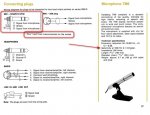Hi,
So I recently bought two old 60's Tandberg TM6's and I'm now trying to plug these into my computer but there is no sound. I have a Scarlett 2i2 interface and no matter what settings I try or how high the gain goes I get no sound except buzzing. At the highest gain the buzz is intolerable but I think I hear a faint voice if I scream right into them however that might be my brain tricking me to hear things that aren't there.
I've also tried hooking them up to a guitar amp with mic in but no sound there at all. They both have a 1/4" cable end that I connect directly into the Scarlett and then Scarlett to computer. I'll attach a picture of how they look. I'm new to microphones so I'm not sure if it is me doing something wrong or if the microphones are busted.
Any help is greatly appreciated.

So I recently bought two old 60's Tandberg TM6's and I'm now trying to plug these into my computer but there is no sound. I have a Scarlett 2i2 interface and no matter what settings I try or how high the gain goes I get no sound except buzzing. At the highest gain the buzz is intolerable but I think I hear a faint voice if I scream right into them however that might be my brain tricking me to hear things that aren't there.
I've also tried hooking them up to a guitar amp with mic in but no sound there at all. They both have a 1/4" cable end that I connect directly into the Scarlett and then Scarlett to computer. I'll attach a picture of how they look. I'm new to microphones so I'm not sure if it is me doing something wrong or if the microphones are busted.
Any help is greatly appreciated.







